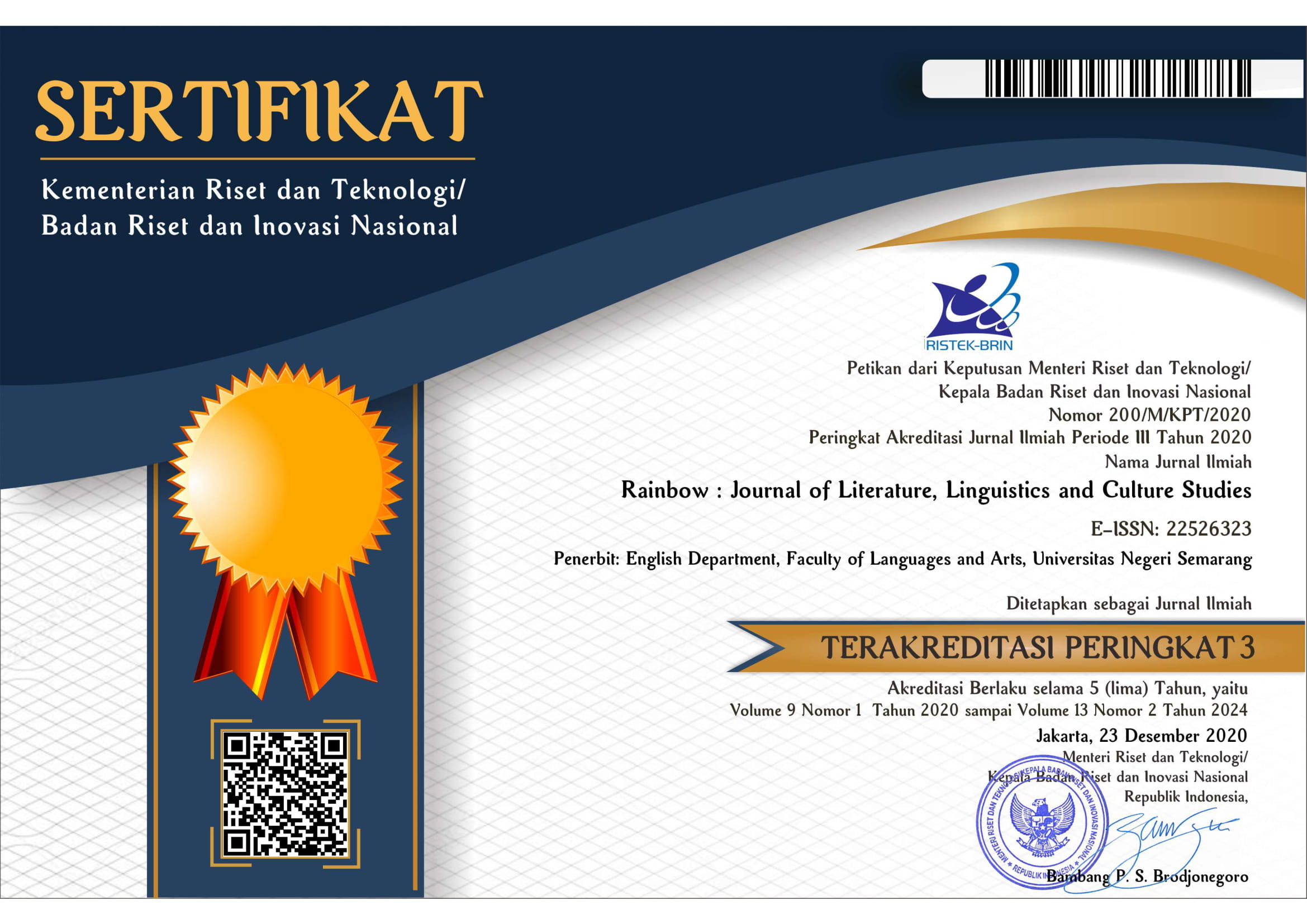WOMAN’S EMANCIPATION DESCRIBED IN PANE’S HABIS GELAP TERBITLAH TERANG AND WALKER’S THE COLOR PURPLE (A COMPARATIVE STUDY)
Abstract
The aim of this article is to find out how woman emancipation in Pane’s Habis Gelap Terbitlah Terang and Walker’s The Color Purple are described by the main characters and also to find out the comparison between them. The objects of this study are characterization, conflict and setting found in Pane’s Habis Gelap Terbitlah Terang and Walker’s The Color Purple. This study is a descriptive qualitative study with sociology in literature as the approach especially feminism. Sociological approach is aimed to reveal the woman’s emancipation described in the novel with condition in the society by its setting. While, feminism is aimed to find how gender equality and the portrayals of women and men inequality in Habis Gelap Terbitlah Terang and Walker’s The Color Purple causing the woman emancipation movement. The data of the study are in the form of words, phrases, sentences, and utterances. Those were gathered by reading the novel thoroughly, identifying, inventorying, classifying, translating and analyzing. The analysis was done by several techniques including exposing, explaining and interpreting. The result of the study shows that Pane’s Habis Gelap Terbitlah Terang reflects behavior and manner of the main character Kartini as woman emancipator. The emancipation of Kartini means a revival of the women struggle through education. Woman emancipator described in Kartini is identified by five characteristics: going forward, educated and inspiring, persistent, self-disclosure, and independent. While, The Color Purple also reflects behavior and manner of the main character Celie as black woman emancipator. As black woman emancipator, Celie is identified by five characteristics: confident and hard worker, persistent, independent, self-disclosure, an uneducated woman. Although she is an uneducated woman, she can be the inspiration for black woman in America to get the same rights to white people. Both of literary works have the similar characteristics of the main characters.The same characteristic which can be the indicators of woman’s emancipation are persistent, self-disclosure, and independent and the victim of woman subordination. The woman’s emancipation between both literary works also has differences from education aspect, culture aspect, economic aspect and the cause of woman emancipation movement.
References
Bassnett, Susan. 1993. Comparative Literature: A Critical Intriduction. UK: Blackwell Publisher.
Djajanegara, S. 2000. Kritik Sastra Feminis: Sebuah Pengtantar. Jakarta: Gramedia Pustaka Utama.
Elizabeth and T. Burns. 1973. Sociology of Literature & Drama. Australia: Penguin Books Inc.
Johnson, A. G. 1986. Human Arrangements: An Introduction to Sociology. The United States of America: Harcourt Brace Jovanovichi, Inc.
Pane, Armijn.2008.Habis Gelap Terbitlah Terang Jakarta : Balai Pustaka
Rees, R. J. 1973. English Literature. An Introduction for Foreign Readers. London: MacMillan Education Limited.
Sapiro, V.1986.Women in American society: An introduction to women's studies. United States. Mayfield Pub. Co. (Palo Alto, Calif.)
Stallknecht, N and Frenz, H.1961. Comparative Literature: Method and Perspective. USA: Southern Illinois University Press.
Sumiarmi, E. 2004. Jender dan Feminisme. Yogyakarta: Wonderful Publising Company.
Walker, Alice. (1982). The Color Purple. USA: Washington Square Press
Webster’s New Twentieth Century Dictionary. 1972. New York: Prentice-Hall press.
Wellek, René and Austin Warren. 1970. Theory of Literature 3rd Edition. New York: Harcourt, Bruce & World, Inc.







